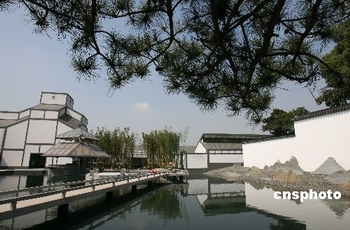I.M. Pei returns to attend opening of Suzhou Museum
时间:2006-10-05 06:32:27
(单词翻译:单击)

| The Suzhou Museum's main exhibits are bronzes and jades1 from between 2,500 years B.C. to 500 B.C. excavated2 from around Suzhou. |
| Oct. 5 - Chinese-American architect Ieoh Ming Pei, better known as I.M. Pei, has brought his love of geometric design back to his family's hometown in China with the opening this week of the new Suzhou Museum.
The angular white and gray building is the latest -- and some say the last -- major design by Pei, 89. New York-based Pei Partnership3 Architects, helmed by Pei's sons Chien Chung and Li Chung, helped design the 15,000-square-meter museum, which includes a 5,000-square-meter exhibition space, a 200-seat auditorium4, research library and several Chinese gardens. ``He used the geometrical form as his basic element and repeated the theme throughout,'' said Jia Beisi, associate professor of architecture at the University of Hong Kong. ``The design looks like a big building cut into smaller pieces.'' Pei was born in 1917 to a Suzhou family. His father, Zu Yi, became head of Bank of China's branch in Hong Kong, the city where Pei spent his boyhood years before heading to the U.S. to study architecture at the University of Pennsylvania and Harvard. The architect, who won the Pritzker Prize in 1983, is best known for the glass Pyramid at the Louvre in Paris. Between 1982 and 1990, he designed the Bank of China Tower in Hong Kong, known locally as the ``Kitchen Knife'' for its tapered5 top and blade- like body. For the Suzhou Museum, Pei softened6 his rigid7 geometrical motif8 to blend with the city's delicate gardens, low-rise brick residences and teahouses along slender canals. Suzhou, known as the ``Venice of the East,'' was known for its poetry, opera and calligraphy9, which flourished during the Ming Dynasty (1368-1644). The museum's main exhibits are bronzes and jades from between 2,500 years B.C. to 500 B.C. excavated from around Suzhou. It will also display works by Suzhou's best painters from the Ming Dynasty, and other exhibits on loan from the Shanghai Museum, according to a press release from Pei Partnership. ``With the white walls and grey tiles, very local building traits, he's integrated the local vernacular10 with his own geometrical style,'' said Jia. ``The project would touch on my relationship with my past, my ancestors, my old home,'' he said in the interview transcript11. The Suzhou Museum, in the northeast of the old section of the city, adjoins the Zhong Wang Fu, a 19th-century residence, and the Garden of the Humble12 Administrator13, a 16th-century garden listed by the United Nations as a World Heritage site.
|
点击 收听单词发音
收听单词发音
 收听单词发音
收听单词发音
1
jades

|
|
| n.玉,翡翠(jade的复数形式)v.(使)疲(jade的第三人称单数形式) | |
参考例句: |
|
|
|
2
excavated

|
|
| v.挖掘( excavate的过去式和过去分词 );开凿;挖出;发掘 | |
参考例句: |
|
|
|
3
partnership

|
|
| n.合作关系,伙伴关系 | |
参考例句: |
|
|
|
4
auditorium

|
|
| n.观众席,听众席;会堂,礼堂 | |
参考例句: |
|
|
|
5
tapered

|
|
| adj. 锥形的,尖削的,楔形的,渐缩的,斜的 动词taper的过去式和过去分词 | |
参考例句: |
|
|
|
6
softened

|
|
| (使)变软( soften的过去式和过去分词 ); 缓解打击; 缓和; 安慰 | |
参考例句: |
|
|
|
7
rigid

|
|
| adj.严格的,死板的;刚硬的,僵硬的 | |
参考例句: |
|
|
|
8
motif

|
|
| n.(图案的)基本花纹,(衣服的)花边;主题 | |
参考例句: |
|
|
|
9
calligraphy

|
|
| n.书法 | |
参考例句: |
|
|
|
10
vernacular

|
|
| adj.地方的,用地方语写成的;n.白话;行话;本国语;动植物的俗名 | |
参考例句: |
|
|
|
11
transcript

|
|
| n.抄本,誊本,副本,肄业证书 | |
参考例句: |
|
|
|
12
humble

|
|
| adj.谦卑的,恭顺的;地位低下的;v.降低,贬低 | |
参考例句: |
|
|
|
13
administrator

|
|
| n.经营管理者,行政官员 | |
参考例句: |
|
|
|
©2005-2010英文阅读网




